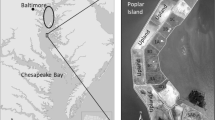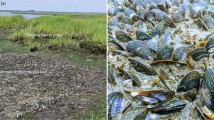Abstract
In Connecticut, cultivation of the northern quahog, or hard clam, Mercenaria mercenaria L., relies on hydraulic dredging. After harvesting, leased shellfish beds remain fallow for varying durations to facilitate natural reseeding and to allow small clams to reach harvestable size. The interval between dredging events, or harvest history, may influence benthic ecology and response of communities to further dredging. Two clam beds with different harvest histories, located near Milford, Connecticut, were studied from July through October 2012. These leased beds, fallowed for 3 and 8 years, respectively, were subdivided into two plots. One plot on each bed was commercially harvested in July while the other remained not dredged. Sediment sampling was conducted on alternate weeks using Smith MacIntyre grabs and sediment cores to compare ecology of benthic communities and chemistry of marine sediments on newly dredged and not dredged plots within leases. Main effects of lease (harvest history), dredging treatment (dredged versus not dredged plots), mean sediment phi size (ɸ), and season (sampling date) significantly affected benthic community structure. Newly settled bivalves, including early successional pioneer species, occurred in high abundance on 3-year beds. Diversity, evenness, and number of species were high on the 8-year beds, while abundance of individuals was low, more typical of later successional equilibrium communities. Differences among a subset of species on the 8-year beds were observed between dredged and not dredged plots while no community differences were observed between dredging treatments on 3-year beds. Significantly more individuals were observed on dredged versus not dredged plots on the 8-year beds only. Our results suggest that harvest frequency and/or sediment ɸ size may explain differences in benthic assemblages between leased areas with different dredging histories, while dredging had no measurable effect on sediment chemistry.



Similar content being viewed by others
Change history
18 October 2017
The original version of this article unfortunately contained an error where the symbol for phi size was inadvertently omitted from the text.
References
Alix RJ, Schreiner W, Meseck SL (2013) Construction of an inexpensive gravity sediment corer for micro-profiling O2 and pH in marine sediments. NOAA Tech Memo NMFS NE 224. National Marine Fisheries Service, Woods Hole, Massachusetts, USA 0254–1026. 13p
Anderson MJ, Gorley RN, Clarke KR (2008) PERMANOVA+ for PRIMER: guide to software and statistical methods. Primer-E Limited, Plymouth, p 214
Busch DA, Loveland RE (1975) Tube-worm-sediment relationships in populations of Pectinaria gouldii (Polychaeta; Pectinariidae) from Barnegat Bay, New Jersey, U.S.A. Mar Biol 33:255–264
Casey MM, Dietl GP, Post DM, Briggs DEG (2014) The impact of eutrophication and commercial fishing on molluscan communities in Long Island Sound, USA. Biol Conserv 170:137–144
Clarke KR, Gorley RN (2006) Primer v6: user manual/tutorial. Primer-E Limited, Plymouth, p 190
Connecticut Dept. of Agriculture, Bureau of Aquaculture (2016) Connecticut shellfish by the numbers. Wracklines 16(1):23
Dernie KM, Kaiser MJ, Warwick RM (2003) Recovery rates of benthic communities following physical disturbance. J Anim Ecol 72:1043–1056
Falcão M, Gaspar MB, Caetano M, Santos MN, Vale C (2003) Short-term environmental impact of clam dredging in coastal waters (south of Portugal): chemical disturbance and subsequent recovery of seabed. Mar Environ Res 56:649–664
Franz D (1976) Benthic molluscan assemblages in relation to sediment gradients in northeastern Long Island Sound, Connecticut. Malacologia 15(2):377–399
Goldberg R, Mercaldo-Allen R, Rose JM, Clark P, Kuropat C, Meseck S, Pereira J (2012) Effects of hydraulic shellfish dredging on the ecology of a cultivated clam bed. Aquac Environ Interact 3:11–21
Goldberg R, Rose JM, Mercaldo-Allen R, Meseck SL, Clark P, Kuropat C, Pereira JJ (2014) Effects of hydraulic dredging on the benthic ecology and sediment chemistry on a cultivated bed of the northern quahog, Mercenaria mercenaria. Aquaculture 428:150–157
Gosner KL (1978) Peterson field guide Atlantic seashore. Houghton Mifflin Company, New York, p 352
Gray JS (1974) Animal-sediment relationships. Oceanogr Mar Biol Annu Rev 12:223–261
Kyte MA, Averill P, Hendershott T (1975) The impact of the hydraulic escalator shellfish harvester on an intertidal soft-shell clam flat in the Harraseeket River, Maine. Maine Department of Marine Resources, Report 31 p
Mancinelli G, Fazi S, Rossi L (1998) Sediment structural properties mediating dominant feeding types patterns in soft-bottom macrobenthos of the northern Adriatic Sea. Hydrobiologia 367:211–222
McCall PL (1977) Community patterns and adaptive strategies of the infaunal benthos of Long Island Sound. J Mar Res 35(2):221–266
Mercaldo-Allen R, Goldberg R (2011) Review of the ecological effects of dredging in the cultivation and harvest of molluscan shellfish. NOAA Technical Memorandum NMFS-NE-220: p 78
Mercaldo-Allen R, Goldberg R, Clark P, Kuropat C, Meseck SL, Rose JM (2016) Benthic ecology of northern quahog beds with different hydraulic dredging histories in Long Island Sound. J Coast Res 32(2):408–415
Meseck SL, Mercaldo-Allen R, Rose JM, Clark P, Kuropat C, Pereira JJ, Goldberg R (2014) Effects of hydraulic shellfish dredging for Mercenaria mercenaria, northern quahog, on sediment biogeochemistry. J World Aquacult Soc 45(3):301–311
Morris PA (1947) A Field Guide to shells of the Atlantic and gulf coasts and the West Indies. Houghton Mifflin Company, Boston, p 350
Nichols FH (1979) Natural and anthropogenic influences on benthic community structure in San Francisco Bay. 58th Annual Meeting of the Pacific Division of the American Association for the Advancement of Science, San Francisco Bay University, San Francisco, California, p. 409–426.
Pollock W (1943) A practical guide to the marine animals of northeastern North America. Rutgers University Press, New Brunswick, p 367
Rhoads DC, McCall PL, Yingst JY (1978) Disturbance and production on the estuarine seafloor: dredge-spoil disposal in estuaries such as Long Island Sound can be managed in ways that enhance productivity rather than diminish it. Am Sci 66(5):577–586
Rosenberg R (2001) Marine benthic faunal successional stages and related sedimentaryactivity. Scientific Marina 65(suppl. 2):107–119
Sanders HL (1956) Biology of marine bottom communities. Bulletin of the Bingham Oceanographic Collection: Oceanography of Long Island Sound 1952-1954(15):345–414
Sanders HL (1958) Benthic studies in Buzzards Bay. I. Animal-sediment relationships. Limnol Oceanogr 3(3):245–258
Smith RI (1964) Keys to marine invertebrates of the Woods Hole region. Marine Biological Laboratory, Woods Hole, MA, p 211
Snelgrove PVR, Butman CA (1994) Animal-sediment relationships revisited: cause versus effect. Oceanogr Mar Biol Annu Rev 32:111–177
Stickney AP, Stringer LD (1957) A study of the invertebrate bottom fauna of Greenwich Bay, Rhode Island. Ecology 38(1):111–122
Thrush SF, Dayton PK (2002) Disturbance to marine benthic habitats by trawling and dredging: implications for marine biodiversity. Annu Rev Ecol Syst 33:449–473
Virnstein RW (1977) The importance of predation by crabs and fishes on benthic infauna in Chesapeake Bay. Ecology 58:1199–1217
Weiss HM (1995) Marine animals of southern New England and New York. Identification keys to common nearshore and shallow water macrofauna. Bulletin 115. State Geological and Natural History Survey of Connecticut, Hartford, p 311
Wentworth CK (1922) A scale of grade and class terms for clastic sediments. J Geol 30:377–392
Whitlatch RB (1974) Food-resource partitioning in the deposit feeding polychaete Pectinaria gouldii. Biol Bull 147(1):227–235
Wilcox RR (2012) Introduction to robust estimation and hypothesis testing, 3rd edn. Elsevier, Amsterdam
Zajac RN, Lewis RS, Poppe LJ, Twichell DC, Vozarik J, DiGiacomo-Cohen ML (2000) Relationships among sea-floor structure and benthic communities in Long Island Sound at regional and benthoscape scales. J Coast Res 16(3):627–640
Zajac RN, Whitlatch RB (1982) Responses of estuarine infauna to disturbance. I. Spatial and temporal variation of initial recolonization. Mar Ecol Prog Ser 10:1–14
Acknowledgements
The authors thank Captains Robert Alix and Werner Schreiner, Genevieve Bernatchez, Kelsey Boeff, Natalie Huey, Joshua Paton, Jose Pereira, and Dylan Redman for the technical assistance and Gary Salce of G. and B. Shellfish Farm, in Stratford, CT, and Larry Williams of Jesse D. Shellfish Company, Milford, CT, for harvesting and for the use of their clam beds for this study. The use of trade names does not imply endorsement.
Author information
Authors and Affiliations
Corresponding author
Additional information
A correction to this article is available online at https://doi.org/10.1007/s10499-017-0208-0.
Rights and permissions
About this article
Cite this article
Mercaldo-Allen, R., Meseck, S., Goldberg, R. et al. Effects of clam dredging on benthic ecology of two cultivated northern quahog beds with different harvest histories and sediment grain sizes. Aquacult Int 25, 1971–1985 (2017). https://doi.org/10.1007/s10499-017-0167-5
Received:
Accepted:
Published:
Issue Date:
DOI: https://doi.org/10.1007/s10499-017-0167-5




